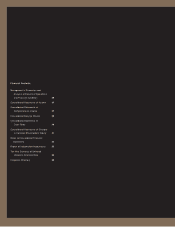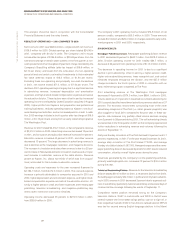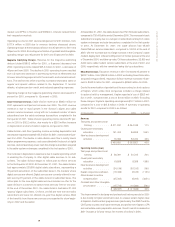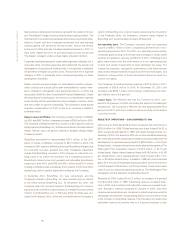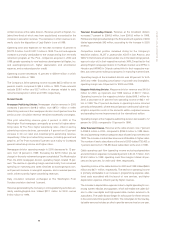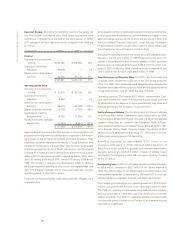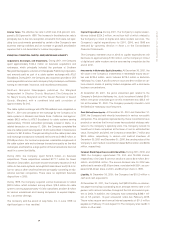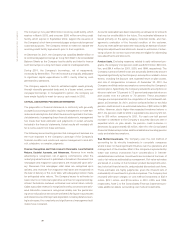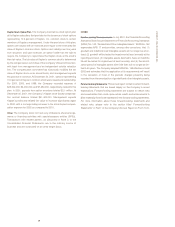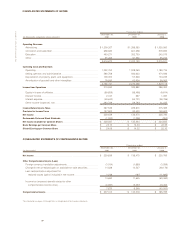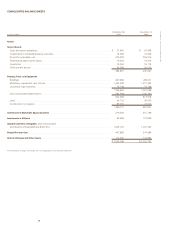Washington Post 2001 Annual Report Download - page 2
Download and view the complete annual report
Please find page 2 of the 2001 Washington Post annual report below. You can navigate through the pages in the report by either clicking on the pages listed below, or by using the keyword search tool below to find specific information within the annual report.
29
MANAGEMENT’S DISCUSSION AND ANALYSIS
OF RESULTS OF OPERATIONS AND FINANCIAL CONDITION
THE WASHINGTON POST COMPANY
This analysis should be read in conjunction with the Consolidated
Financial Statements and the notes thereto.
RESULTS OF OPERATIONS — 2001 COMPARED TO 2000
Net income for 2001 was $229.6 million, compared with net income of
$136.5 million for 2000. Diluted earnings per share totaled $24.06 in
2001, compared with $14.32 in 2000. The Company’s 2001 results
include after-tax gains of $196.5 million, or $20.69 per share, from the
sale and exchange of certain cable systems in the first quarter; a non-
cash goodwill and other intangibles impairment charge recorded by the
Company’s BrassRing affiliate (after-tax impact of $19.9 million, or
$2.10 per share); and losses from the write-down of a non-operating
parcel of land and certain cost method investments to their estimated
fair value (after-tax impact of $18.3 million, or $1.93 per share).
Excluding these non-operating and principally non-cash transactions
in 2001, net income totaled $71.3 million, or $7.40 per share. The
decline in 2001 operating earnings is largely due to a significant decline
in advertising revenue, increased depreciation and amortization
expenses, and higher stock-based compensation expense accruals at
the education division. These factors were offset in part by increased
operating income contributed by Quest Education (acquired in August
2000), higher profits from Kaplan’s test preparation and professional
training businesses, reduced operating losses at Kaplan’s new busi-
ness development activities, and an increased pension credit. In addi-
tion, 2000 earnings included a fourth quarter after-tax charge of $16.5
million, or $1.74 per share, arising from an early retirement program at
The Washington Post.
Revenue for 2001 totaled $2,416.7 million, or flat compared to revenue
of $2,412.2 million in 2000. Advertising revenue decreased 13 percent
in 2001, and circulation and subscriber revenue increased 10 percent.
Education revenue increased 40 percent in 2001, and other revenue
decreased 10 percent. The large decrease in advertising revenue is
due to declines at the newspaper, television, and magazine divisions.
The increase in circulation and subscriber revenue is due to a 20 per-
cent increase in Newsweek domestic circulation revenue and a 10 per-
cent increase in subscriber revenue at the cable division. Revenue
growth at Kaplan, Inc. (about two-thirds of which was from acquisi-
tions) accounted for the increase in education revenue.
Operating costs and expenses for the year increased 6 percent to
$2,196.7 million, from $2,072.3 million in 2000. The cost and expense
increase is primarily attributable to companies acquired in 2001 and
2000, higher depreciation and amortization expense, and higher stock-
based compensation expense accruals at the education division, off-
set by a higher pension credit and lower expenses at the newspaper
publishing, television broadcasting, and magazine publishing seg-
ments due to extensive cost control initiatives.
Operating income decreased 35 percent to $219.9 million in 2001,
from $339.9 million in 2000.
The Company’s 2001 operating income includes $76.9 million of net
pension credits, compared to $65.3 million in 2000. These amounts
exclude $3.3 million and $29.0 million in charges related to early retire-
ment programs in 2001 and 2000, respectively.
DIVISION RESULTS
Newspaper Publishing Division. Newspaper publishing division revenue
in 2001 decreased 8 percent to $842.7 million, from $918.2 million in
2000. Division operating income for 2001 totaled $84.7 million, a
decrease of 26 percent from operating income of $114.4 million in 2000.
The decrease in operating income for 2001 is due to a significant
decline in print advertising, offset in part by a higher pension credit,
higher online advertising revenue, lower newsprint cost, cost control
initiatives employed throughout the division, and the $27.5 million
charge recorded in the fourth quarter of 2000 in connection with an
early retirement program completed at The Post.
Print advertising revenue at The Washington Post newspaper
decreased 14 percent to $574.3 million, from $664.1 million in 2000.
Volume declines of 41 percent in classified recruitment advertising for
2001 caused classified recruitment advertising revenue declines of 37
percent. The economic environment surrounding most of the other
advertising categories at The Post (i.e., retail, general, preprints) was
also sluggish for fiscal 2001 compared to the prior year. In these cat-
egories, rate increases only partially offset volume declines ranging
from 3 percent to 28 percent during 2001. The soft advertising climate
worsened late in the third quarter of 2001 as the Company experienced
further reductions in advertising revenue and volumes following the
events of September 11.
Daily and Sunday circulation at The Post declined 0.5 percent and 0.7
percent, respectively, in 2001. For the year ended December 30, 2001,
average daily circulation at The Post totaled 773,000, and average
Sunday circulation totaled 1,067,000. Newsprint expense at the news-
paper publishing division decreased 6 percent for 2001 due to reduced
consumption, offset by overall higher prices during the year.
Revenues generated by the Company’s online publishing activities,
primarily washingtonpost.com, increased 12 percent to $30.4 million
during the year.
Television Broadcasting Division. Revenue for the television broadcasting
division totaled $314.0 million for 2001, a 14 percent decline from 2000.
Excluding approximately $42 million in political and Olympics advertis-
ing in 2000, revenue in 2001 decreased 3 percent due to a general soft-
ness in advertising (particularly national advertising) and several days of
commercial-free coverage following the events of September 11.
Competitive market position remained strong for the Company’s
television stations. WJXT in Jacksonville and WDIV in Detroit were
ranked number one in the latest ratings period, sign-on to sign-off, in
their respective markets; KSAT in San Antonio ranked second; WPLG
was tied for second among English-language stations in the Miami

